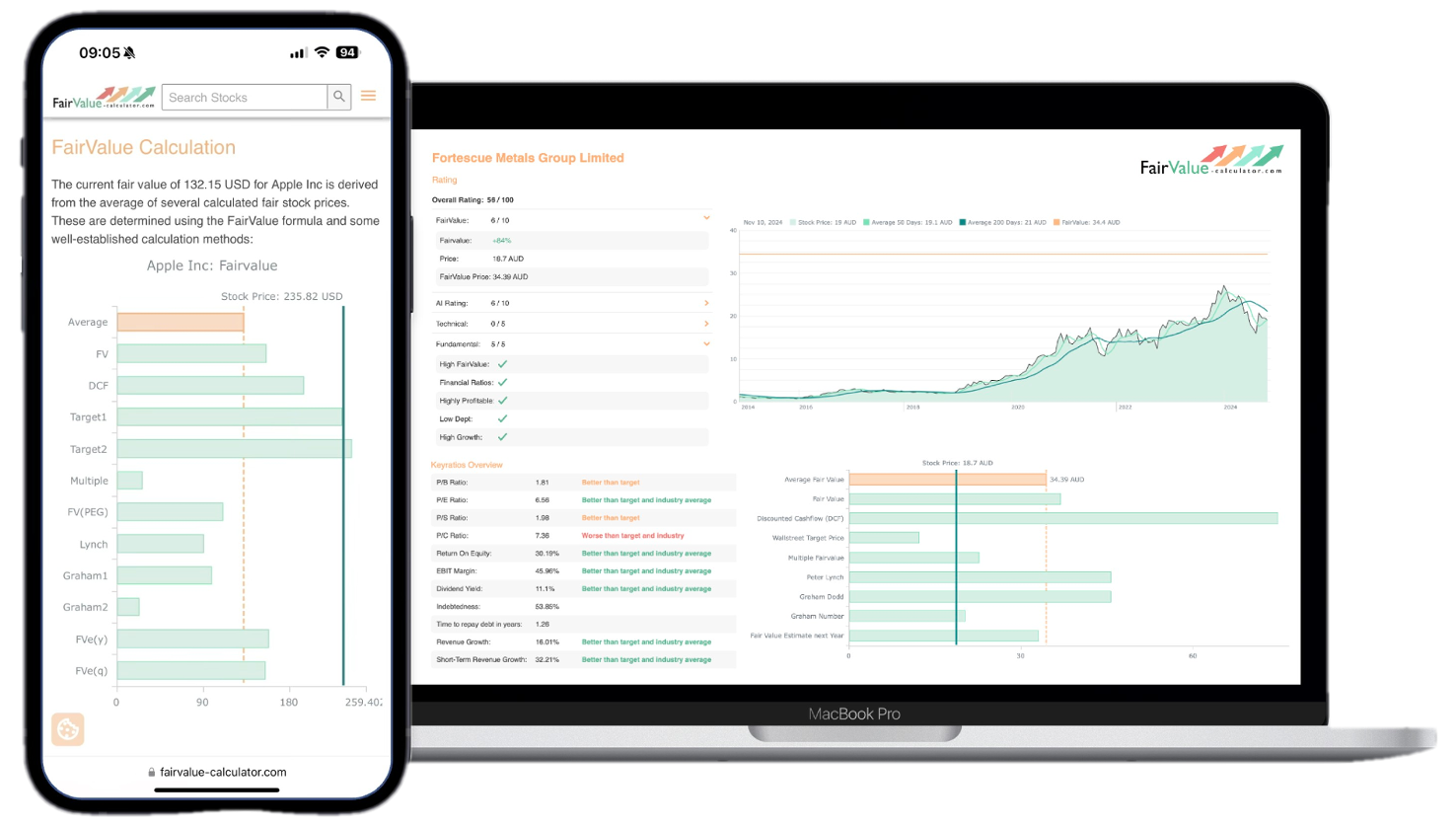The traditional financial paradigm assumes market participants act rationally, processing information efficiently to arrive at accurate asset valuations. However, the field of behavioral finance challenges this assumption by examining how psychological biases and cognitive limitations influence financial decision-making. This article explores the intersection of human psychology and asset valuation, revealing how behavioral factors create market inefficiencies while offering insights for investment professionals seeking to navigate these complexities.
💡 Discover Powerful Investing Tools
Stop guessing – start investing with confidence. Our Fair Value Stock Calculators help you uncover hidden value in stocks using time-tested methods like Discounted Cash Flow (DCF), Benjamin Graham’s valuation principles, Peter Lynch’s PEG ratio, and our own AI-powered Super Fair Value formula. Designed for clarity, speed, and precision, these tools turn complex valuation models into simple, actionable insights – even for beginners.
Learn More About the Tools →🚀 Test the Fair Value Calculator Now!
Find out in seconds whether your stock is truly undervalued or overpriced – based on fundamentals and future growth.
Try it for Free →The Evolution of Behavioral Finance
Behavioral finance emerged as a response to anomalies that traditional financial theories struggled to explain. The field represents a significant departure from the Efficient Market Hypothesis (EMH), which posits that asset prices fully reflect all available information, making it impossible to consistently outperform the market.
Explore our most popular stock fair value calculators to find opportunities where the market price is lower than the true value.
- Peter Lynch Fair Value – Combines growth with valuation using the PEG ratio. A favorite among growth investors.
- Buffett Intrinsic Value Calculator – Based on Warren Buffett’s long-term DCF approach to determine business value.
- Buffett Fair Value Model – Simplified version of his logic with margin of safety baked in.
- Graham & Dodd Fair Value – Uses conservative earnings-based valuation from classic value investing theory.
- Intrinsic vs. Extrinsic Value – Learn the core difference between what a company’s really worth and what others pay.
- Intrinsic Value Calculator – A general tool to estimate the true value of a stock, based on earnings potential.
- Fama-French Model – For advanced users: Quantifies expected return using size, value and market risk.
- Discount Rate Calculator – Helps estimate the proper rate to use in any DCF-based valuation model.
Historical Development
The intellectual foundations of behavioral finance were established through pioneering work by psychologists Daniel Kahneman and Amos Tversky in the 1970s. Their research on decision-making under uncertainty revealed systematic biases in human judgment that contradicted rational economic models. Economists Richard Thaler, Robert Shiller, and others subsequently applied these insights to financial markets, demonstrating how psychological factors could explain market anomalies.
From Fringe to Mainstream
Initially viewed with skepticism by the financial establishment, behavioral finance has gained widespread acceptance following multiple market events that defied rational explanation:
- The October 1987 market crash, when the Dow Jones Industrial Average fell 22.6% in a single day without significant news
- The dot-com bubble of the late 1990s, characterized by extreme valuations divorced from fundamental analysis
- The 2008 financial crisis, which exposed systemic irrationality in credit markets
- The meme stock phenomenon of 2021, demonstrating how social dynamics can override traditional valuation metrics
The awarding of the Nobel Prize in Economics to Daniel Kahneman in 2002 and Richard Thaler in 2017 cemented behavioral finance’s place in economic theory. Today, the field provides essential insights for investment professionals seeking to understand market behavior beyond the constraints of purely rational models.
Key Behavioral Biases Affecting Asset Valuation
Understanding the psychological factors that influence market participants provides valuable context for asset valuation discrepancies. Several well-documented biases consistently impact pricing across markets and asset classes.
Overconfidence and Optimism
Investors systematically overestimate their knowledge, abilities, and the precision of their forecasts.
This overconfidence manifests in several ways:
- Illusion of control: Believing one can influence random outcomes
- Calibration errors: Consistently underestimating the range of possible outcomes
- Better-than-average effect: Most investors believe their skills exceed the median
- Hindsight bias: Overestimating the predictability of past events
These tendencies lead to excessive trading, insufficient diversification, and unrealistic growth projections in valuation models. Analysts frequently produce overly precise estimates that fail to account for uncertainty, resulting in valuation errors that persist across market cycles.
Loss Aversion and Prospect Theory
Kahneman and Tversky’s prospect theory revealed that investors feel losses more intensely than equivalent gains—typically by a factor of 2:1. This asymmetric utility function explains several valuation anomalies:
- The disposition effect, where investors hold losing positions too long and sell winners too early
- The equity premium puzzle, which suggests stocks historically offered returns exceeding what rational risk models would predict
- The endowment effect, where people value assets more highly once they own them
Loss aversion creates particular challenges for asset valuation during market downturns, as investors may demand excessive risk premiums that distort pricing relative to fundamental value.
Herd Behavior and Social Influence
Humans are inherently social creatures who look to others for guidance, especially in uncertain situations.
In financial markets, this tendency manifests as:
- Information cascades: Decision chains where later participants follow early adopters regardless of private information
- Groupthink: Suppression of dissenting views within investment committees
- Reputational concerns: Preference for “conventional failure” over “unconventional success”
These social dynamics can drive asset prices far from intrinsic value during momentum-driven markets, as evidenced by historical bubbles in tulips, technology stocks, real estate, and cryptocurrencies. Valuation models that fail to account for these social factors often misinterpret market pricing signals.
Anchoring and Adjustment
Investors heavily weight initial reference points when making estimates, even when these anchors are arbitrary or outdated.
This cognitive shortcut affects valuation in multiple ways:
- Excessive influence of purchase prices on selling decisions
- Undue weight given to historical valuation metrics
- Insufficient adjustment from initial analyst estimates
- Price targets that cluster around current market prices
Research shows that even experienced professional investors remain susceptible to anchoring effects, limiting the market’s ability to efficiently incorporate new information into prices.
Availability and Recency Biases
The human mind assesses probability based on how easily examples come to mind, overweighting recent, vivid, or emotionally charged information.
This creates predictable patterns in asset valuation:
- Excessive attention to recent performance when projecting future returns
- Overreaction to dramatic news events regardless of fundamental significance
- Catastrophic risk assessment that fluctuates based on recent disasters
- Alternating market regimes of complacency and panic
These recency effects create systematic mispricing that value investors can potentially exploit, particularly following market dislocations when emotional reactions override rational analysis.
Framing and Mental Accounting
How information is presented significantly impacts decision-making. Investors categorize financial outcomes into separate mental accounts, treating each differently despite the fungibility of money.
This affects valuation through:
- Different risk tolerance across investment “buckets”
- Inconsistent discount rates applied to various cash flow streams
- The dividend puzzle, where investors irrationally prefer dividends despite tax disadvantages
- Distinct treatment of paper gains versus realized gains
These framing effects create persistent valuation discrepancies, particularly in how investors assess income versus capital appreciation potential.
Behavioral Finance in Asset Class Valuation
The impact of behavioral biases varies across asset classes, creating unique valuation challenges in different market segments.
Equity Markets
Stock markets exhibit particularly pronounced behavioral effects due to their liquidity and transparency.
Key phenomena include:
- P/E ratio fluctuations: Historical market P/E ratios have ranged from 5x to 45x, far exceeding what fundamental changes in growth or interest rates would justify
- Momentum effects: Stocks that have performed well continue outperforming in the short term, contradicting efficient market predictions
- Size and value premiums: Smaller companies and those with lower price-to-book ratios have historically outperformed, suggesting systematic mispricing
- Earnings surprises: Market reactions to earnings announcements exhibit drift patterns suggesting inefficient information processing
Behavioral perspectives help explain why equity valuations frequently deviate from intrinsic value estimates, creating opportunities for contrarian investors while posing challenges for index followers.
Fixed Income Markets
Bond markets, despite their quantitative nature, also exhibit behavioral influences:
- Yield curve anomalies: Behavioral factors contribute to the persistence of certain yield curve shapes beyond what risk fundamentals would predict
- Credit spreads: Bond spreads frequently overreact to market sentiment rather than reflecting actual default probabilities
- Convexity preferences: Investors systematically misprice bond convexity due to cognitive difficulties with non-linear relationships
- Inflation expectations: Psychological anchoring affects inflation forecasts, influencing real yield calculations
These effects create particular challenges for fixed-income valuation models that assume purely rational pricing mechanisms.
Real Estate
The real estate market demonstrates pronounced behavioral characteristics:
- Sticky prices: Sellers resist lowering prices during downturns due to loss aversion and anchoring to purchase prices
- Comparable sales methodology: Appraisal practices institutionalize anchoring biases
- Cyclical financing: Lending standards fluctuate with market sentiment rather than fundamental risk assessment
- Development patterns: Overconfidence drives excess construction during booms despite historical cyclicality
These factors contribute to real estate’s characteristic boom-bust cycles that defy rational market expectations.
Alternative Investments
Private equity, venture capital, and hedge funds present unique behavioral challenges:
- Illiquidity premiums: Behavioral preferences for liquidity create inconsistent pricing of illiquidity risk
- Performance persistence: Institutional investors chase past performance despite limited evidence of skill persistence
- Narrative-driven valuations: Early-stage investments rely heavily on compelling stories that activate confirmation bias
- Status signaling: Access to exclusive funds creates social utility beyond financial returns
The limited transparency in alternative investments can amplify behavioral effects, creating significant valuation discrepancies between private and public markets.
Professional Applications of Behavioral Finance
Investment professionals can apply behavioral insights to improve valuation accuracy and investment outcomes.
Enhancing Fundamental Analysis
Traditional valuation techniques can be augmented with behavioral awareness:
- Scenario analysis: Expanding DCF models to incorporate a wider range of outcomes
- Reverse engineering: Working backward from current prices to identify implied assumptions
- Sentiment indicators: Incorporating contrarian signals into valuation frameworks
- Psychological adjustments: Systematically questioning growth projections during euphoric markets
These approaches help analysts identify when market pricing deviates from fundamental value due to behavioral factors.
Institutional Safeguards
Investment organizations can implement processes to mitigate behavioral biases:
- Pre-commitment mechanisms: Documenting investment theses before making decisions
- Devil’s advocate roles: Assigning team members to challenge consensus views
- Standardized valuation frameworks: Reducing inconsistency in how assets are evaluated
- Decision journals: Recording reasoning to reduce hindsight bias
These structures help investment committees avoid common decision-making pitfalls that lead to valuation errors.
Quantitative Approaches
Quantitative strategies can systematically exploit behavioral biases:
- Value factor investing: Capitalizing on market overreaction to negative news
- Quality factor investing: Exploiting investor underappreciation of sustainable competitive advantages
- Momentum strategies: Leveraging herding behavior in the short term
- Low volatility anomaly: Benefiting from investors’ preference for lottery-like payoffs
These approaches transform behavioral understanding into actionable investment strategies with measurable results.
Implications for Market Efficiency and Valuation Theory
Behavioral finance necessitates a rethinking of traditional views on market efficiency and asset pricing.
Adaptive Markets Hypothesis
Andrew Lo’s Adaptive Markets Hypothesis offers a synthesis of behavioral and efficient market perspectives, suggesting that:
- Market efficiency exists on a continuum rather than as a binary state
- Efficiency evolves as market participants adapt to changing conditions
- Behavioral biases persist but create opportunities for adaptation and learning
- Investment strategies experience cyclical performance as markets evolve
This framework helps explain why markets can appear efficient in some contexts while exhibiting persistent behavioral anomalies in others.
The Dual-Process Brain and Valuation
Neuroscience research on dual-process cognition (System 1 vs. System 2 thinking) provides insights into why valuation errors occur:
- Fast, intuitive thinking struggles with probability assessment and statistical reasoning
- Emotional responses frequently override analytical judgments during market stress
- Cognitive resources are limited, leading to mental shortcuts when analyzing complex situations
- Analytical thinking requires deliberate effort that market participants often skip
Understanding these cognitive limitations helps explain why sophisticated valuation models can fail to predict actual market behavior.
The Role of Institutional Structures
Market institutions themselves reflect and sometimes amplify behavioral tendencies:
- Short-term performance evaluation encourages myopic decision-making
- Benchmark-relative mandates create herding incentives
- Career risk considerations discourage contrarian positioning
- Compensation structures may reward asset gathering over valuation discipline
These institutional factors create persistent valuation inefficiencies even among sophisticated investors.
The Future of Behavioral Asset Valuation
Several emerging trends suggest behavioral finance will play an increasingly important role in asset valuation.
Technology and Decision Support
Technological advances are creating new tools to mitigate behavioral biases:
- Artificial intelligence systems that identify potential decision errors
- Data visualization techniques that improve probability assessment
- Decision architecture platforms that structure investment processes
- Sentiment analysis tools that quantify market psychology
These technologies help bridge the gap between theoretical valuation models and behaviorally-influenced market prices.
Regulatory Considerations
Regulatory frameworks increasingly acknowledge behavioral factors:
- Disclosure requirements designed with behavioral insights
- Financial literacy initiatives addressing cognitive limitations
- Consideration of market sentiment in systemic risk assessment
- Recognition of behavioral exploitation in market conduct rules
These developments suggest public policy is evolving to address behavioral market inefficiencies.
Interdisciplinary Integration
The future of asset valuation likely involves greater integration across disciplines:
- Neurofinance: Applying neuroscience insights to understand market behavior
- Ecological rationality: Recognizing the evolutionary basis of decision heuristics
- Computational social science: Modeling complex social dynamics in markets
- Digital anthropology: Studying how technology shapes financial behavior
This interdisciplinary approach promises more comprehensive valuation models that account for the full complexity of human decision-making.
Conclusion: Toward Behaviorally-Informed Valuation
Behavioral finance fundamentally challenges the notion that asset prices simply reflect an objective calculation of discounted future cash flows. Instead, it reveals how psychological factors create a complex interplay between market sentiment and fundamental value.
For investment professionals, this understanding offers both challenges and opportunities. The challenges include recognizing one’s own biases and developing safeguards against them. The opportunities lie in identifying persistent behavioral patterns that create exploitable valuation discrepancies.
Rather than viewing behavioral finance as undermining traditional valuation approaches, forward-thinking investors integrate these insights to develop more robust methodologies. By acknowledging the human element in markets, they gain a more nuanced understanding of asset prices that neither purely rational models nor pure behavioral explanations can provide alone.
In a financial landscape increasingly shaped by complex human interactions, behavioral awareness represents not just an academic curiosity but an essential practical skill for anyone engaged in asset valuation. The most successful investment approaches will likely be those that balance quantitative rigor with psychological insight, recognizing that markets, ultimately, reflect the aggregated decisions of imperfectly rational human beings operating within evolving social structures.
FAQs
1. What is the impact of behavioral finance on asset valuation? Behavioral finance shows that investor psychology and biases can cause assets to be mispriced, either overvalued or undervalued, compared to their intrinsic value. These emotional factors often lead to market inefficiencies that traditional financial models may not predict.
2. What is the value effect in behavioral finance? The value effect refers to the tendency of undervalued stocks (those with low price-to-earnings or price-to-book ratios) to outperform overvalued growth stocks over time. Behavioral finance explains this by highlighting biases like overconfidence and herd behavior, which can cause investors to misjudge the true worth of assets.
3. What is behavioral finance in asset management? In asset management, behavioral finance is used to understand and predict how cognitive biases and emotional reactions influence investor decisions. Portfolio managers leverage these insights to design strategies that aim to exploit predictable patterns in market behavior.
4. How does behavioral finance affect investment strategies? Behavioral finance impacts investment strategies by encouraging the development of methods that account for irrational investor behavior. Strategies might include value investing, contrarian approaches, or momentum investing, each designed to capitalize on common psychological tendencies in the market.
5. What is the main objective of behavioral finance? The main objective of behavioral finance is to bridge the gap between traditional financial theory, which assumes rational decision-making, and the real-world behaviors of investors, which are often influenced by emotions and cognitive biases.
6. What is the benefit of understanding behavioral finance? Understanding behavioral finance helps investors and financial professionals make more informed decisions by recognizing common psychological pitfalls. It also provides tools to better anticipate market movements, manage risk, and potentially improve investment performance by avoiding irrational mistakes.







